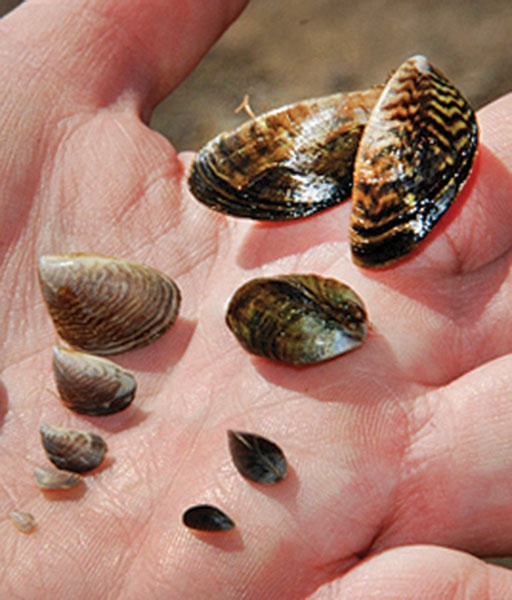By Joe Fries
An unexpected parental leave was partly to blame for a near-miss in the Shuswap that could have caused the depletion of fish species the likes of which agencies are working hard to prevent.
The threat at Shuswap Lake in July 2012 appeared in the form of thumbnail-size quagga mussels attached to a boat arriving from the U.S.
Quagga and zebra mussels multiply quickly and spread easily as stowaways in, and on, boats. The mussels cause harm by attaching themselves to in-lake equipment, like dams and water intakes, and washing up on beaches where their shells make walking difficult. They also strain nutrients from water, to the detriment of other aquatic life.
A report prepared this year for the Okanagan Basin Water Board estimated the annual cost to taxpayers could hit $40 million in the first few years of an invasion here.
To help sink the threat, the Okanagan Basin Water Board launched this summer’s Don’t Move A Mussel awareness campaign aimed at boaters, and is also funding a separate surveillance program.
“We think it’s probably one of the most important issues to hit the lake in the last 40 years, so we think it’s important people know about it,” said OBWB executive director Anna Warwick Sears.
The OBWB has also asked the federal government to establish inspection stations at B.C.’s international and interprovincial borders.
It might have also prevented the panic at Shuswap Lake that was revealed in documents obtained by Black Press under freedom of information legislation.
On June 23, 2012, the primary contact for B.C.’s aquatic invasive species program received an email from counterparts in Idaho warning that a boat contaminated with mussels had just passed through on its way north.
Despite the advanced warning, the boat made it into Shuswap Lake, where it was moored for a week before conservation officers ordered its removal on July 3, 2012.
That delay had officials worried.
“Best case scenario here is that all the mussels were dead and we don’t have a problem,” Ted Down, the B.C. Environment Ministry’s manager of ecosystem protection, wrote in a July 3 email to colleagues.
“Worst case would be missing the opportunity to contain viable mussels at the marina and having them become established in Shuswap, resulting in the decimation of fisheries stocks including key sockeye stocks.”
Test results later revealed the mussels attached to the boat were dead.
Environment Ministry spokesperson Dave Crebo said in a statement the 10-day lag between Idaho issuing the warning and B.C. taking action was due to a staffing issue.
“The response protocol in place at the time of this incident followed the Columbia River Zebra and Quagga Mussel Rapid Response Plan,” Crebo said.
“However, the one provincial staff person tasked with responding, unexpectedly had to depart on parental leave earlier than planned, resulting in a gap of a few days before the backfill staff person was in place.”
NDP environment critic Spencer Chandra Herbert said the incident revealed a gap in the province’s defences against invasive species.
“Just one person not being at their job could have put hundreds, if not thousands, of people out of work. That seems like a pretty thin line of defence,” he said.
Since the near-miss in the Shuswap the “response protocol has been improved by having additional provincial staff available 24-7 to respond to reports of mussel-infested boats,” Crebo said.
